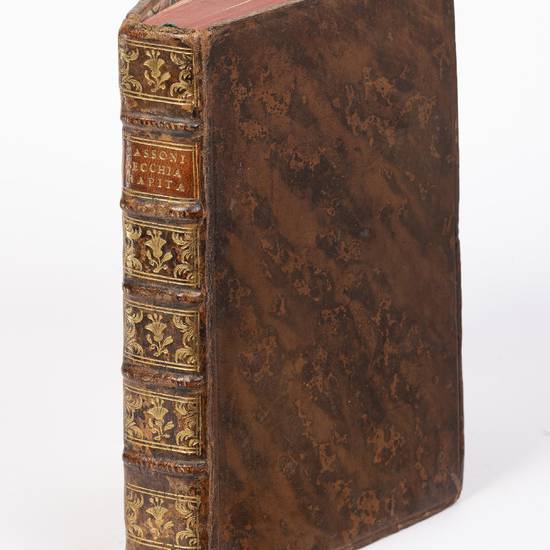La secchia rapita poema eroicomico di Alessandro Tassoni patrizio modenese, colle dichiarazioni di Gaspare Salviani romano, s'aggiungono la prefazione, e le annotazioni di Giannandrea Barotti ferrarese, le varie lezioni de' testi a penna, e di molte edizioni; e la vita del poeta composta da Lodovico Antonio Muratori [...] Seconda edizione
Autore: TASSONI, Alessandro (1565-1635)
Tipografo: Bartolomeo Soliani
Dati tipografici: Modena, 1744
8vo (205x130 mm). [4], 1-94, [2], 95-508 pp. and a folding genealogical table (Tavola genealogica de' personaggi della casa Tassoni di Modena). Included in the text are the frontispiece, the author's portrait, a woodcut illustration of the tower of Modena called ‘Ghirlandina' (repeated 4 times), and 12 full-page woodcut plates at the beginning of each canto. Title page printed in red and black with a woodcut vignette in the center. Issue B with the addition of a single leaf, inserted after p. 94, containing the Appendice alla vita di Alessandro Tassoni, but without the folding plate with the Mostra del carattere di Alessandro Tassoni, which appears only in the copies of issue C after p. 122. Contemporary marbled calf gilt, lettering piece on spine, marbled endleaves, red edges (very slightly worn at places). On the front pastedown engraved bookplate of the Counts Cantuti Castelvetri. A fine copy.
This is the editio minor compared to the 4to edition that Soliani issued in the same year, but maior if compared to the 24mo edition printed by Soliani in 1743. The woodcut illustrations, although simpler and coarser than the ones engraved for the major edition, are, from a certain point of view, closer to and more representative of the comic-satirical spirit of the poem.
The first edition of the Secchia printed in Modena, Tassoni's hometown, was that edited by Antonio Capponi in 1700, almost 80 years after the first Paris edition of 1622. The Capponi edition did not only appear very late but was also extremely incorrect, so in the Modena's cultural circles, dominated at the time by the dominating figure of L.A. Muratori, the need was felt to urgently fill this gap by publishing an edition that was both philologically correct and typographically outstanding as a homage of the city's elite to the memory of Tassoni. “In this context, the three editions by Bartolomeo Soliani, [the 24mo edition of 1743 and the 4to and 8vo editions of 1744], constituted a major publishing event. Preceded by a long preparatory work, they filled an almost secular gap and, responding to a deeply felt cultural need, they fulfilled the twofold task of proposing a philologically accurate text - the one commissioned by Urban VIII - and of offering, at least in two of them, a first-rate series of illustrations” (P. Puliatti, Bibliografia di Alessandro Tassoni, Florence, 1969, p. 184).
The text was edited by G.A. Barotti (1701-1772), who used the revised text of the second Ronciglione edition, printed in 1624 in accordance with the dictates of Urban VIII, collating it with the manuscripts and other editions. In the preface he outlined a brief history of the composition of the Secchia, for the first time indicating 1614 as the postquem date for the beginning of the composition. In the notes at the end he points out facts and figures from the poet's time and makes learned linguistic observations, recalling the poem's sources. The text he prepared was used for all three Soliani editions (cf. D.B.I., VI, p. 486-487).
Puliatti, op. cit., nos. 128-129; Gamba, 2097; Passigli, V, 265.
[10078]








